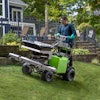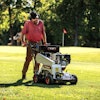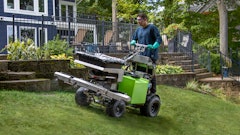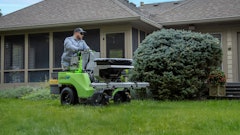
Fall is here, and it's important to know that while temperatures drop outside, soil conditions also change. This results in a few changes in turfgrass and creates optimum environments for disease to take over.
There are a few actionable recommendations for preventing lawn disease. Generally, disease loves shady, moist areas in the lawn. Reducing this kind of environment will help significantly.
Reduce watering
Start by reducing the amount of moisture in the lawn by changing watering habits if watering too frequently. Still water the lawn to prevent stress—just reduce the amount of time spent doing this. Watering in the mornings is recommended so that the sunlight helps the lawn dry before cooler temperatures occur during nightfall. Water the lawn less frequently and water deeper during the times scheduled for irrigation.
Manage fallen leaves
Remove fallen leaves during this time of year as well. Leaves create shady areas in the lawn that encourage disease due to the lack of sunlight.
Loosen compact soil
Make sure the soil is absorbing the water appropriately. If there is really compact soil where water tends to pool up, consider aerating or raking in a mix of topsoil to help.
Apply fungicide preventively
One of the best recommendations for preventing lawn disease is to make preventive applications of a systemic fungicide. This helps to prevent lawn disease from occurring in the first place.
It is recommended to apply a fungicide at preventive rates around this time as it will help the grass enter colder months in a healthier condition. Lawn care operators may need multiple applications in affected areas from the past. If spring dead spot was a problem, apply a fungicide at high rates to the problem area(s). Consider mapping those areas because fungicide treatment can be expensive. If using a granular fungicide variety, water the lawn immediately after application to help with soil absorption.
Fungicides can be applied at two rates: preventively or curatively. Preventive rates are less than curative rates. Preventive application rates should be used to prevent lawn disease whereas curative application rates should be used to “cure” an already present disease.
An ounce of prevention is worth a pound of cure. In other words, preventive application rates are significantly less than curative application rates for lawn disease. Since more fungicide is applied at a curative application rate, lawn care operators will also spend more money.
What are some common lawn diseases in the fall?
As with any lawn disease, the type of fungus an area experiences depends on the climate and location. However, some of the most common lawn diseases we see in the fall are brown patch, take-all root rot (TARR), large patch and dollar spot.
Most bags or bottles of fungicide will instruct users on how much to apply, but generally speaking, curative rates are four to five times higher than preventive rates. Active ingredients for fungicides can range from azoxystrobin, fluoxastrobin, triadimefon + trifloxystrobin, thiophanate-methyl, myclobutanil and others.
Lastly, ensure the lawn is properly fertilized with the right amount of nutrients will ensure that the grass bounces back from disease or insect pressure pretty quickly.



















